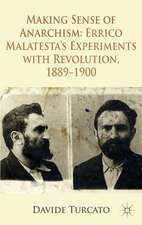The Key to Nuclear Restraint: The Swedish Plans to Acquire Nuclear Weapons During the Cold War
Autor Thomas Jonteren Limba Engleză Hardback – 13 mai 2016
| Toate formatele și edițiile | Preț | Express |
|---|---|---|
| Paperback (1) | 585.26 lei 43-57 zile | |
| Palgrave Macmillan UK – 31 mai 2021 | 585.26 lei 43-57 zile | |
| Hardback (1) | 749.39 lei 43-57 zile | |
| Palgrave Macmillan UK – 13 mai 2016 | 749.39 lei 43-57 zile |
Preț: 749.39 lei
Preț vechi: 881.63 lei
-15% Nou
Puncte Express: 1124
Preț estimativ în valută:
143.44€ • 155.86$ • 120.57£
143.44€ • 155.86$ • 120.57£
Carte tipărită la comandă
Livrare economică 21 aprilie-05 mai
Preluare comenzi: 021 569.72.76
Specificații
ISBN-13: 9781137581129
ISBN-10: 1137581123
Pagini: 293
Ilustrații: XIV, 293 p.
Dimensiuni: 148 x 210 x 23 mm
Greutate: 5.0099999999999998 kg
Ediția:1st ed. 2016
Editura: Palgrave Macmillan UK
Colecția Palgrave Macmillan
Locul publicării:London, United Kingdom
ISBN-10: 1137581123
Pagini: 293
Ilustrații: XIV, 293 p.
Dimensiuni: 148 x 210 x 23 mm
Greutate: 5.0099999999999998 kg
Ediția:1st ed. 2016
Editura: Palgrave Macmillan UK
Colecția Palgrave Macmillan
Locul publicării:London, United Kingdom
Cuprins
Introduction. - 1.The ideas to initiate a nuclear weapons program started to grow. - 2. The development of a latent capability of producing nuclear weapons, 1945–59. - 3. The United States and Sweden’s plans to acquire nuclear weapons, 1945-62. - 4. The political debate: 1954–60. - 5. Abandoning the nuclear weapons plans: 1961–75. - 6. Conclusions
Notă biografică
Thomas Jonter is Director of Stockholm University Graduate School of International Studies, Sweden, and Professor of International Relations at the Department of Economic History. He has been visiting scholar at Stockholm International Peace Research Institute (SIPRI), Stanford University, and Cornell University. Professor Jonter is also chair of Swedish Pugwash and served as advisor to the Swedish delegation to the 2015 Review Conference to the Treaty on the Non-proliferation of Nuclear Weapons, at the United Nations in New York.
Textul de pe ultima copertă
Why have some nations acquired nuclear weapons while others have refrained from doing so? Most research related to this question has focused on states that have built nuclear weapons, yet little attention has been devoted to countries that have chosen nuclear restraint. This book analyzes Swedish plans to acquire nuclear weapons during the Cold War. Sweden was very close to putting a bomb together in 1960s but, for a number of reasons illuminated in this book, decision makers abandoned those plans and subsequently rose to become one of the most recognized players in the international game of disarmament. Thanks to the recent declassification of essential documentation in Sweden and United States, it is now possible to assemble a comprehensive analysis of the Swedish nuclear weapons program based on primary sources. This book presents that analysis, a unique perspective owing to the fact that nuclear development is a highly secretive activity in most countries – with non-existent orlimited access to state archives.
Caracteristici
Analyzes Swedish plans to acquire nuclear weapons during the Cold War Demonstrates how decision makers abandoned rose to become one of the most recognized players in the international game of disarmament














